尚硅谷大数据技术之Hadoop(MapReduce) 第3章 MapReduce框架原理
3.1 MapReduce工作流程
1)流程示意图


2)流程详解
上面的流程是整个mapreduce最全工作流程,但是shuffle过程只是从第7步开始到第16步结束,具体shuffle过程详解,如下:
1)maptask收集我们的map()方法输出的kv对,放到内存缓冲区中
2)从内存缓冲区不断溢出本地磁盘文件,可能会溢出多个文件
3)多个溢出文件会被合并成大的溢出文件
4)在溢出过程中,及合并的过程中,都要调用partitioner进行分区和针对key进行排序
5)reducetask根据自己的分区号,去各个maptask机器上取相应的结果分区数据
6)reducetask会取到同一个分区的来自不同maptask的结果文件,reducetask会将这些文件再进行合并(归并排序)
7)合并成大文件后,shuffle的过程也就结束了,后面进入reducetask的逻辑运算过程(从文件中取出一个一个的键值对group,调用用户自定义的reduce()方法)
3)注意
Shuffle中的缓冲区大小会影响到mapreduce程序的执行效率,原则上说,缓冲区越大,磁盘io的次数越少,执行速度就越快。
缓冲区的大小可以通过参数调整,参数:io.sort.mb 默认100M。
3.2 InputFormat数据输入
3.2.1 Job提交流程和切片源码详解
1)job提交流程源码详解
|
waitForCompletion() submit(); // 1建立连接 connect(); // 1)创建提交job的代理 new Cluster(getConfiguration()); // (1)判断是本地yarn还是远程 initialize(jobTrackAddr, conf); // 2 提交job submitter.submitJobInternal(Job.this, cluster) // 1)创建给集群提交数据的Stag路径 Path jobStagingArea = JobSubmissionFiles.getStagingDir(cluster, conf); // 2)获取jobid ,并创建job路径 JobID jobId = submitClient.getNewJobID(); // 3)拷贝jar包到集群 copyAndConfigureFiles(job, submitJobDir); rUploader.uploadFiles(job, jobSubmitDir); // 4)计算切片,生成切片规划文件 writeSplits(job, submitJobDir); maps = writeNewSplits(job, jobSubmitDir); input.getSplits(job); // 5)向Stag路径写xml配置文件 writeConf(conf, submitJobFile); conf.writeXml(out); // 6)提交job,返回提交状态 status = submitClient.submitJob(jobId, submitJobDir.toString(), job.getCredentials()); |
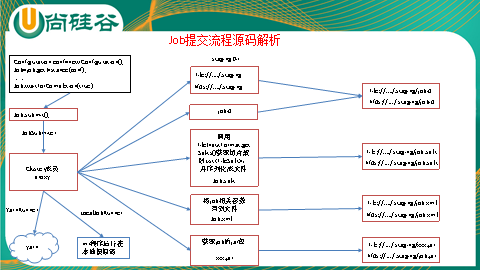
2)FileInputFormat源码解析(input.getSplits(job))
(1)找到你数据存储的目录。
(2)开始遍历处理(规划切片)目录下的每一个文件
(3)遍历第一个文件ss.txt
a)获取文件大小fs.sizeOf(ss.txt)
b)计算切片大小computeSliteSize(Math.max(minSize,Math.min(maxSize,blocksize)))=blocksize=128M
c)默认情况下,切片大小=blocksize
d)开始切,形成第1个切片:ss.txt—0:128M 第2个切片ss.txt—128:256M 第3个切片ss.txt—256M:300M(每次切片时,都要判断切完剩下的部分是否大于块的1.1倍,不大于1.1倍就划分一块切片)
e)将切片信息写到一个切片规划文件中
f)整个切片的核心过程在getSplit()方法中完成
g)数据切片只是在逻辑上对输入数据进行分片,并不会再磁盘上将其切分成分片进行存储。InputSplit只记录了分片的元数据信息,比如起始位置、长度以及所在的节点列表等
h)注意:block是HDFS物理上存储的数据,切片是对数据逻辑上的划分
(4)提交切片规划文件到yarn上,yarn上的MrAppMaster就可以根据切片规划文件计算开启maptask个数。
3.2.2 FileInputFormat切片机制
1)FileInputFormat中默认的切片机制:
(1)简单地按照文件的内容长度进行切片
(2)切片大小,默认等于block大小
(3)切片时不考虑数据集整体,而是逐个针对每一个文件单独切片
比如待处理数据有两个文件:
|
file1.txt 320M file2.txt 10M |
经过FileInputFormat的切片机制运算后,形成的切片信息如下:
|
file1.txt.split1-- 0~128 file1.txt.split2-- 128~256 file1.txt.split3-- 256~320 file2.txt.split1-- 0~10M |
2)FileInputFormat切片大小的参数配置
通过分析源码,在FileInputFormat中,计算切片大小的逻辑:Math.max(minSize, Math.min(maxSize, blockSize));
切片主要由这几个值来运算决定
mapreduce.input.fileinputformat.split.minsize=1 默认值为1
mapreduce.input.fileinputformat.split.maxsize= Long.MAXValue 默认值Long.MAXValue
因此,默认情况下,切片大小=blocksize。
maxsize(切片最大值):参数如果调得比blocksize小,则会让切片变小,而且就等于配置的这个参数的值。
minsize(切片最小值):参数调的比blockSize大,则可以让切片变得比blocksize还大。
3)获取切片信息API
|
// 根据文件类型获取切片信息 FileSplit inputSplit = (FileSplit) context.getInputSplit(); // 获取切片的文件名称 String name = inputSplit.getPath().getName(); |
3.2.3 CombineTextInputFormat切片机制
关于大量小文件的优化策略
1)默认情况下TextInputformat对任务的切片机制是按文件规划切片,不管文件多小,都会是一个单独的切片,都会交给一个maptask,这样如果有大量小文件,就会产生大量的maptask,处理效率极其低下。
2)优化策略
(1)最好的办法,在数据处理系统的最前端(预处理/采集),将小文件先合并成大文件,再上传到HDFS做后续分析。
(2)补救措施:如果已经是大量小文件在HDFS中了,可以使用另一种InputFormat来做切片(CombineTextInputFormat),它的切片逻辑跟TextFileInputFormat不同:它可以将多个小文件从逻辑上规划到一个切片中,这样,多个小文件就可以交给一个maptask。
(3)优先满足最小切片大小,不超过最大切片大小
CombineTextInputFormat.setMaxInputSplitSize(job, 4194304);// 4m
CombineTextInputFormat.setMinInputSplitSize(job, 2097152);// 2m
举例:0.5m+1m+0.3m+5m=2m + 4.8m=2m + 4m + 0.8m
3)具体实现步骤
|
// 如果不设置InputFormat,它默认用的是TextInputFormat.class job.setInputFormatClass(CombineTextInputFormat.class) CombineTextInputFormat.setMaxInputSplitSize(job, 4194304);// 4m CombineTextInputFormat.setMinInputSplitSize(job, 2097152);// 2m |
3.2.4 CombineTextInputFormat案例实操
1)需求:将输入的大量小文件合并成一个切片统一处理。
2)输入数据:准备5个小文件
3)实现过程
(1)不做任何处理,运行需求1中的wordcount程序,观察切片个数为5
(2)在WordcountDriver中增加如下代码,运行程序,并观察运行的切片个数为1
|
// 如果不设置InputFormat,它默认用的是TextInputFormat.class job.setInputFormatClass(CombineTextInputFormat.class); CombineTextInputFormat.setMaxInputSplitSize(job, 4194304);// 4m CombineTextInputFormat.setMinInputSplitSize(job, 2097152);// 2m |
3.2.5 InputFormat接口实现类
MapReduce任务的输入文件一般是存储在HDFS里面。输入的文件格式包括:基于行的日志文件、二进制格式文件等。这些文件一般会很大,达到数十GB,甚至更大。那么MapReduce是如何读取这些数据的呢?下面我们首先学习InputFormat接口。
InputFormat常见的接口实现类包括:TextInputFormat、KeyValueTextInputFormat、NLineInputFormat、CombineTextInputFormat和自定义InputFormat等。
1)TextInputFormat
TextInputFormat是默认的InputFormat。每条记录是一行输入。键是LongWritable类型,存储该行在整个文件中的字节偏移量。值是这行的内容,不包括任何行终止符(换行符和回车符)。
以下是一个示例,比如,一个分片包含了如下4条文本记录。
|
Rich learning form Intelligent learning engine Learning more convenient From the real demand for more close to the enterprise |
每条记录表示为以下键/值对:
|
(0,Rich learning form) (19,Intelligent learning engine) (47,Learning more convenient) (72,From the real demand for more close to the enterprise) |
很明显,键并不是行号。一般情况下,很难取得行号,因为文件按字节而不是按行切分为分片。
2)KeyValueTextInputFormat
每一行均为一条记录,被分隔符分割为key,value。可以通过在驱动类中设置conf.set(KeyValueLineRecordReader.KEY_VALUE_SEPERATOR, " ");来设定分隔符。默认分隔符是tab(\t)。
以下是一个示例,输入是一个包含4条记录的分片。其中——>表示一个(水平方向的)制表符。
|
line1 ——>Rich learning form line2 ——>Intelligent learning engine line3 ——>Learning more convenient line4 ——>From the real demand for more close to the enterprise |
每条记录表示为以下键/值对:
|
(line1,Rich learning form) (line2,Intelligent learning engine) (line3,Learning more convenient) (line4,From the real demand for more close to the enterprise) |
此时的键是每行排在制表符之前的Text序列。
3)NLineInputFormat
如果使用NlineInputFormat,代表每个map进程处理的InputSplit不再按block块去划分,而是按NlineInputFormat指定的行数N来划分。即输入文件的总行数/N=切片数,如果不整除,切片数=商+1。
以下是一个示例,仍然以上面的4行输入为例。
|
Rich learning form Intelligent learning engine Learning more convenient From the real demand for more close to the enterprise |
例如,如果N是2,则每个输入分片包含两行。开启2个maptask。
|
(0,Rich learning form) (19,Intelligent learning engine) |
另一个 mapper 则收到后两行:
|
(47,Learning more convenient) (72,From the real demand for more close to the enterprise) |
这里的键和值与TextInputFormat生成的一样。
3.2.6 KeyValueTextInputFormat使用案例
1)需求:统计输入文件中每一行的第一个单词相同的行数。
2)输入文件:
banzhang ni hao
xihuan hadoop banzhang dc
banzhang ni hao
xihuan hadoop banzhang dc
3)输出
banzhang 2
xihuan 2
4)代码实现
(1)编写mapper
|
package com.atguigu.mapreduce.KeyValueTextInputFormat; import java.io.IOException; import org.apache.hadoop.io.LongWritable; import org.apache.hadoop.io.Text; import org.apache.hadoop.mapreduce.Mapper;
public class KVTextMapper extends Mapper<Text, Text, Text, LongWritable>{ final Text k = new Text(); final LongWritable v = new LongWritable();
@Override protected void map(Text key, Text value, Context context) throws IOException, InterruptedException { // banzhang ni hao // 1 设置key和value // banzhang k.set(key); // 设置key的个数 v.set(1);
// 2 写出 context.write(k, v); } } |
(2)编写reducer
|
package com.atguigu.mapreduce.KeyValueTextInputFormat; import java.io.IOException; import org.apache.hadoop.io.LongWritable; import org.apache.hadoop.io.Text; import org.apache.hadoop.mapreduce.Reducer;
public class KVTextReducer extends Reducer<Text, LongWritable, Text, LongWritable>{ LongWritable v = new LongWritable();
@Override protected void reduce(Text key, Iterable<LongWritable> values, Context context) throws IOException, InterruptedException { long count = 0L; // 1 汇总统计 for (LongWritable value : values) { count += value.get(); }
v.set(count);
// 2 输出 context.write(key, v); } } |
(3)编写Driver
|
package com.atguigu.mapreduce.keyvaleTextInputFormat; import java.io.IOException; import org.apache.hadoop.conf.Configuration; import org.apache.hadoop.fs.Path; import org.apache.hadoop.io.LongWritable; import org.apache.hadoop.io.Text; import org.apache.hadoop.mapreduce.Job; import org.apache.hadoop.mapreduce.lib.input.FileInputFormat; import org.apache.hadoop.mapreduce.lib.input.KeyValueLineRecordReader; import org.apache.hadoop.mapreduce.lib.input.KeyValueTextInputFormat; import org.apache.hadoop.mapreduce.lib.output.FileOutputFormat;
public class MyDriver {
public static void main(String[] args) throws IOException, ClassNotFoundException, InterruptedException { Configuration conf = new Configuration(); // 设置切割符 conf.set(KeyValueLineRecordReader.KEY_VALUE_SEPERATOR, " "); // 获取job对象 Job job = Job.getInstance(conf); // 设置jar包位置,关联mapper和reducer job.setJarByClass(MyDriver.class); job.setMapperClass(MyMapper.class); job.setOutputValueClass(LongWritable.class); // 设置map输出kv类型 job.setMapOutputKeyClass(Text.class); job.setMapOutputValueClass(LongWritable.class);
// 设置最终输出kv类型 job.setReducerClass(MyReducer.class); job.setOutputKeyClass(Text.class); // 设置输入输出数据路径 FileInputFormat.setInputPaths(job, new Path(args[0])); // 设置输入格式 job.setInputFormatClass(KeyValueTextInputFormat.class); // 设置输出数据路径 FileOutputFormat.setOutputPath(job, new Path(args[1])); // 提交job job.waitForCompletion(true); } } |
3.2.7 NLineInputFormat使用案例
1)需求:根据每个输入文件的行数来规定输出多少个切片。例如每三行放入一个切片中。
2)输入数据:
banzhang ni hao
xihuan hadoop banzhang dc
banzhang ni hao
xihuan hadoop banzhang dc
banzhang ni hao
xihuan hadoop banzhang dc
banzhang ni hao
xihuan hadoop banzhang dc
banzhang ni hao
xihuan hadoop banzhang dcbanzhang ni hao
xihuan hadoop banzhang dc
3)输出结果:
Number of splits:4
4)代码实现:
(1)编写mapper
|
package com.atguigu.mapreduce.nline; import java.io.IOException; import org.apache.hadoop.io.LongWritable; import org.apache.hadoop.io.Text; import org.apache.hadoop.mapreduce.Mapper;
public class NLineMapper extends Mapper<LongWritable, Text, Text, LongWritable>{ private Text k = new Text(); private LongWritable v = new LongWritable(1); @Override protected void map(LongWritable key, Text value, Context context) throws IOException, InterruptedException { // 1 获取一行 final String line = value.toString();
// 2 切割 final String[] splited = line.split(" ");
// 3 循环写出 for (int i = 0; i < splited.length; i++) {
k.set(splited[i]);
context.write(k, v); } } } |
(2)编写Reducer
|
package com.atguigu.mapreduce.nline; import java.io.IOException; import org.apache.hadoop.io.LongWritable; import org.apache.hadoop.io.Text; import org.apache.hadoop.mapreduce.Reducer;
public class NLineReducer extends Reducer<Text, LongWritable, Text, LongWritable>{ LongWritable v = new LongWritable(); @Override protected void reduce(Text key, Iterable<LongWritable> values, Context context) throws IOException, InterruptedException { long count = 0l; // 1 汇总 for (LongWritable value : values) { count += value.get(); }
v.set(count);
// 2 输出 context.write(key, v); } } |
(3)编写driver
|
package com.atguigu.mapreduce.nline; import java.io.IOException; import java.net.URISyntaxException; import org.apache.hadoop.conf.Configuration; import org.apache.hadoop.fs.Path; import org.apache.hadoop.io.LongWritable; import org.apache.hadoop.io.Text; import org.apache.hadoop.mapreduce.Job; import org.apache.hadoop.mapreduce.lib.input.FileInputFormat; import org.apache.hadoop.mapreduce.lib.input.NLineInputFormat; import org.apache.hadoop.mapreduce.lib.output.FileOutputFormat;
public class NLineDriver { public static void main(String[] args) throws IOException, URISyntaxException, ClassNotFoundException, InterruptedException { // 获取job对象 Configuration configuration = new Configuration(); Job job = Job.getInstance(configuration);
// 设置每个切片InputSplit中划分三条记录 NLineInputFormat.setNumLinesPerSplit(job, 3);
// 使用NLineInputFormat处理记录数 job.setInputFormatClass(NLineInputFormat.class);
// 设置jar包位置,关联mapper和reducer job.setJarByClass(NLineDriver.class); job.setMapperClass(NLineMapper.class); job.setReducerClass(NLineReducer.class);
// 设置map输出kv类型 job.setMapOutputKeyClass(Text.class); job.setMapOutputValueClass(LongWritable.class);
// 设置最终输出kv类型 job.setOutputKeyClass(Text.class); job.setOutputValueClass(LongWritable.class);
// 设置输入输出数据路径 FileInputFormat.setInputPaths(job, new Path(args[0])); FileOutputFormat.setOutputPath(job, new Path(args[1]));
// 提交job job.waitForCompletion(true); } } |
5)结果查看
(1)输入数据
banzhang ni hao
xihuan hadoop banzhang dc
banzhang ni hao
xihuan hadoop banzhang dc
banzhang ni hao
xihuan hadoop banzhang dc
banzhang ni hao
xihuan hadoop banzhang dc
banzhang ni hao
xihuan hadoop banzhang dcbanzhang ni hao
xihuan hadoop banzhang dc
(2)输出结果的切片数:
3.2.8 自定义InputFormat
1)概述
(1)自定义一个类继承FileInputFormat。
(2)改写RecordReader,实现一次读取一个完整文件封装为KV。
(3)在输出时使用SequenceFileOutPutFormat输出合并文件。
3.2.9 自定义InputFormat案例实操
1)需求
无论hdfs还是mapreduce,对于小文件都有损效率,实践中,又难免面临处理大量小文件的场景,此时,就需要有相应解决方案。将多个小文件合并成一个文件SequenceFile,SequenceFile里面存储着多个文件,存储的形式为文件路径+名称为key,文件内容为value。
2)输入数据
one:
yongpeng weidong weinan
sanfeng luozong xiaoming
two:
longlong fanfan
mazong kailun yuhang yixin
longlong fanfan
mazong kailun yuhang yixin
three:
shuaige changmo zhenqiang
dongli lingu xuanxuan
最终预期文件格式:
https://share.weiyun.com/5lXqV6v
3)分析
小文件的优化无非以下几种方式:
(1)在数据采集的时候,就将小文件或小批数据合成大文件再上传HDFS
(2)在业务处理之前,在HDFS上使用mapreduce程序对小文件进行合并
(3)在mapreduce处理时,可采用CombineTextInputFormat提高效率
4)具体实现
本节采用自定义InputFormat的方式,处理输入小文件的问题。
(1)自定义一个类继承FileInputFormat
(2)改写RecordReader,实现一次读取一个完整文件封装为KV
(3)在输出时使用SequenceFileOutPutFormat输出合并文件
5)程序实现:
(1)自定义InputFromat
|
package com.atguigu.mapreduce.inputformat; import java.io.IOException; import org.apache.hadoop.fs.Path; import org.apache.hadoop.io.BytesWritable; import org.apache.hadoop.io.NullWritable; import org.apache.hadoop.mapreduce.InputSplit; import org.apache.hadoop.mapreduce.JobContext; import org.apache.hadoop.mapreduce.RecordReader; import org.apache.hadoop.mapreduce.TaskAttemptContext; import org.apache.hadoop.mapreduce.lib.input.FileInputFormat;
// 定义类继承FileInputFormat public class WholeFileInputformat extends FileInputFormat<NullWritable, BytesWritable>{ @Override protected boolean isSplitable(JobContext context, Path filename) { return false; }
@Override public RecordReader<NullWritable, BytesWritable> createRecordReader(InputSplit split, TaskAttemptContext context) throws IOException, InterruptedException { WholeRecordReader recordReader = new WholeRecordReader(); recordReader.initialize(split, context); return recordReader; } } |
(2)自定义RecordReader
|
package com.atguigu.mapreduce.inputformat; import java.io.IOException; import org.apache.hadoop.conf.Configuration; import org.apache.hadoop.fs.FSDataInputStream; import org.apache.hadoop.fs.FileSystem; import org.apache.hadoop.fs.Path; import org.apache.hadoop.io.BytesWritable; import org.apache.hadoop.io.IOUtils; import org.apache.hadoop.io.NullWritable; import org.apache.hadoop.mapreduce.InputSplit; import org.apache.hadoop.mapreduce.RecordReader; import org.apache.hadoop.mapreduce.TaskAttemptContext; import org.apache.hadoop.mapreduce.lib.input.FileSplit;
public class WholeRecordReader extends RecordReader<NullWritable, BytesWritable>{
private Configuration configuration; private FileSplit split; private boolean processed = false; private BytesWritable value = new BytesWritable(); @Override public void initialize(InputSplit split, TaskAttemptContext context) throws IOException, InterruptedException { this.split = (FileSplit)split; configuration = context.getConfiguration(); }
@Override public boolean nextKeyValue() throws IOException, InterruptedException { if (!processed) { // 1 定义缓存区 byte[] contents = new byte[(int)split.getLength()]; FileSystem fs = null; FSDataInputStream fis = null; try { // 2 获取文件系统 Path path = split.getPath(); fs = path.getFileSystem(configuration); // 3 读取数据 fis = fs.open(path); // 4 读取文件内容 IOUtils.readFully(fis, contents, 0, contents.length); // 5 输出文件内容 value.set(contents, 0, contents.length); } catch (Exception e) { }finally { IOUtils.closeStream(fis); } processed = true; return true; } return false; }
@Override public NullWritable getCurrentKey() throws IOException, InterruptedException { return NullWritable.get(); }
@Override public BytesWritable getCurrentValue() throws IOException, InterruptedException { return value; }
@Override public float getProgress() throws IOException, InterruptedException { return processed? 1:0; }
@Override public void close() throws IOException { } } |
(3)SequenceFileMapper处理流程
|
package com.atguigu.mapreduce.inputformat; import java.io.IOException; import org.apache.hadoop.io.BytesWritable; import org.apache.hadoop.io.NullWritable; import org.apache.hadoop.io.Text; import org.apache.hadoop.mapreduce.Mapper; import org.apache.hadoop.mapreduce.lib.input.FileSplit;
public class SequenceFileMapper extends Mapper<NullWritable, BytesWritable, Text, BytesWritable>{ Text k = new Text(); @Override protected void setup(Mapper<NullWritable, BytesWritable, Text, BytesWritable>.Context context) throws IOException, InterruptedException { // 1 获取文件切片信息 FileSplit inputSplit = (FileSplit) context.getInputSplit(); // 2 获取切片名称 String name = inputSplit.getPath().toString(); // 3 设置key的输出 k.set(name); } @Override protected void map(NullWritable key, BytesWritable value, Context context) throws IOException, InterruptedException {
context.write(k, value); } } |
(4)SequenceFileReducer处理流程
|
package com.atguigu.mapreduce.inputformat; import java.io.IOException; import org.apache.hadoop.io.BytesWritable; import org.apache.hadoop.io.Text; import org.apache.hadoop.mapreduce.Reducer;
public class SequenceFileReducer extends Reducer<Text, BytesWritable, Text, BytesWritable> {
@Override protected void reduce(Text key, Iterable<BytesWritable> values, Context context) throws IOException, InterruptedException {
context.write(key, values.iterator().next()); } } |
(5)SequenceFileDriver处理流程
|
package com.atguigu.mapreduce.inputformat; import java.io.IOException; import org.apache.hadoop.conf.Configuration; import org.apache.hadoop.fs.Path; import org.apache.hadoop.io.BytesWritable; import org.apache.hadoop.io.Text; import org.apache.hadoop.mapreduce.Job; import org.apache.hadoop.mapreduce.lib.input.FileInputFormat; import org.apache.hadoop.mapreduce.lib.output.FileOutputFormat; import org.apache.hadoop.mapreduce.lib.output.SequenceFileOutputFormat;
public class SequenceFileDriver {
public static void main(String[] args) throws IOException, ClassNotFoundException, InterruptedException { args = new String[] { "e:/input/inputinputformat", "e:/output1" }; Configuration conf = new Configuration();
Job job = Job.getInstance(conf); job.setJarByClass(SequenceFileDriver.class); job.setMapperClass(SequenceFileMapper.class); job.setReducerClass(SequenceFileReducer.class);
// 设置输入的inputFormat job.setInputFormatClass(WholeFileInputformat.class); // 设置输出的outputFormat job.setOutputFormatClass(SequenceFileOutputFormat.class);
job.setMapOutputKeyClass(Text.class); job.setMapOutputValueClass(BytesWritable.class); job.setOutputKeyClass(Text.class); job.setOutputValueClass(BytesWritable.class);
FileInputFormat.setInputPaths(job, new Path(args[0])); FileOutputFormat.setOutputPath(job, new Path(args[1]));
boolean result = job.waitForCompletion(true);
System.exit(result ? 0 : 1); } } |
3.3 MapTask工作机制
3.3.1 并行度决定机制
1)问题引出
maptask的并行度决定map阶段的任务处理并发度,进而影响到整个job的处理速度。那么,mapTask并行任务是否越多越好呢?
2)MapTask并行度决定机制
一个job的map阶段MapTask并行度(个数),由客户端提交job时的切片个数决定。
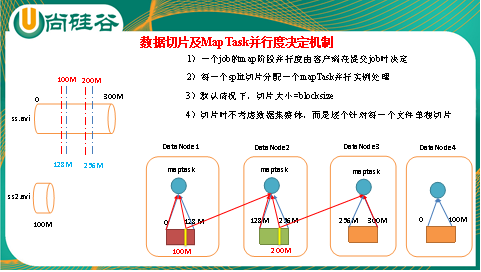
3.3.2 MapTask工作机制
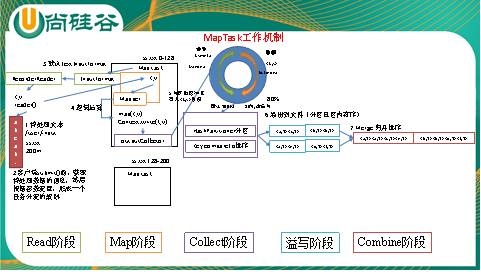
(1)Read阶段:Map Task通过用户编写的RecordReader,从输入InputSplit中解析出一个个key/value。
(2)Map阶段:该节点主要是将解析出的key/value交给用户编写map()函数处理,并产生一系列新的key/value。
(3)Collect收集阶段:在用户编写map()函数中,当数据处理完成后,一般会调用OutputCollector.collect()输出结果。在该函数内部,它会将生成的key/value分区(调用Partitioner),并写入一个环形内存缓冲区中。
(4)Spill阶段:即“溢写”,当环形缓冲区满后,MapReduce会将数据写到本地磁盘上,生成一个临时文件。需要注意的是,将数据写入本地磁盘之前,先要对数据进行一次本地排序,并在必要时对数据进行合并、压缩等操作。
溢写阶段详情:
步骤1:利用快速排序算法对缓存区内的数据进行排序,排序方式是,先按照分区编号partition进行排序,然后按照key进行排序。这样,经过排序后,数据以分区为单位聚集在一起,且同一分区内所有数据按照key有序。
步骤2:按照分区编号由小到大依次将每个分区中的数据写入任务工作目录下的临时文件output/spillN.out(N表示当前溢写次数)中。如果用户设置了Combiner,则写入文件之前,对每个分区中的数据进行一次聚集操作。
步骤3:将分区数据的元信息写到内存索引数据结构SpillRecord中,其中每个分区的元信息包括在临时文件中的偏移量、压缩前数据大小和压缩后数据大小。如果当前内存索引大小超过1MB,则将内存索引写到文件output/spillN.out.index中。
(5)Combine阶段:当所有数据处理完成后,MapTask对所有临时文件进行一次合并,以确保最终只会生成一个数据文件。
当所有数据处理完后,MapTask会将所有临时文件合并成一个大文件,并保存到文件output/file.out中,同时生成相应的索引文件output/file.out.index。
在进行文件合并过程中,MapTask以分区为单位进行合并。对于某个分区,它将采用多轮递归合并的方式。每轮合并io.sort.factor(默认100)个文件,并将产生的文件重新加入待合并列表中,对文件排序后,重复以上过程,直到最终得到一个大文件。
让每个MapTask最终只生成一个数据文件,可避免同时打开大量文件和同时读取大量小文件产生的随机读取带来的开销。
3.4 Shuffle机制
3.4.1 Shuffle机制
Mapreduce确保每个reducer的输入都是按键排序的。系统执行排序的过程(即将map输出作为输入传给reducer)称为shuffle。

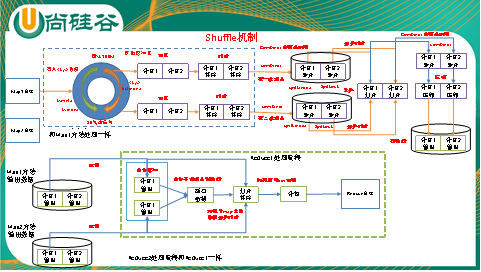
3.4.2 Partition分区
0)问题引出:要求将统计结果按照条件输出到不同文件中(分区)。比如:将统计结果按照手机归属地不同省份输出到不同文件中(分区)
1)默认partition分区
|
public class HashPartitioner<K, V> extends Partitioner<K, V> { public int getPartition(K key, V value, int numReduceTasks) { return (key.hashCode() & Integer.MAX_VALUE) % numReduceTasks; } } |
默认分区是根据key的hashCode对reduceTasks个数取模得到的。用户没法控制哪个key存储到哪个分区。
2)自定义Partitioner步骤
(1)自定义类继承Partitioner,重写getPartition()方法
|
public class ProvincePartitioner extends Partitioner<Text, FlowBean> {
@Override public int getPartition(Text key, FlowBean value, int numPartitions) {
// 1 获取电话号码的前三位 String preNum = key.toString().substring(0, 3); int partition = 4; // 2 判断是哪个省 if ("136".equals(preNum)) { partition = 0; }else if ("137".equals(preNum)) { partition = 1; }else if ("138".equals(preNum)) { partition = 2; }else if ("139".equals(preNum)) { partition = 3; } return partition; } } |
(2)在job驱动中,设置自定义partitioner:
|
job.setPartitionerClass(CustomPartitioner.class); |
(3)自定义partition后,要根据自定义partitioner的逻辑设置相应数量的reduce task
|
job.setNumReduceTasks(5); |
3)注意:
如果reduceTask的数量> getPartition的结果数,则会多产生几个空的输出文件part-r-000xx;
如果1<reduceTask的数量<getPartition的结果数,则有一部分分区数据无处安放,会Exception;
如果reduceTask的数量=1,则不管mapTask端输出多少个分区文件,最终结果都交给这一个reduceTask,最终也就只会产生一个结果文件 part-r-00000;
例如:假设自定义分区数为5,则
(1)job.setNumReduceTasks(1);会正常运行,只不过会产生一个输出文件
(2)job.setNumReduceTasks(2);会报错
(3)job.setNumReduceTasks(6);大于5,程序会正常运行,会产生空文件
3.4.3 Partition分区案例实操
1)需求:将统计结果按照手机归属地不同省份输出到不同文件中(分区)
2)数据准备
3)分析
(1)Mapreduce中会将map输出的kv对,按照相同key分组,然后分发给不同的reducetask。默认的分发规则为:根据key的hashcode%reducetask数来分发
(2)如果要按照我们自己的需求进行分组,则需要改写数据分发(分组)组件Partitioner
自定义一个CustomPartitioner继承抽象类:Partitioner
(3)在job驱动中,设置自定义partitioner: job.setPartitionerClass(CustomPartitioner.class)
4)在案例2.4的基础上,增加一个分区类
|
package com.atguigu.mapreduce.flowsum; import org.apache.hadoop.io.Text; import org.apache.hadoop.mapreduce.Partitioner;
public class ProvincePartitioner extends Partitioner<Text, FlowBean> {
@Override public int getPartition(Text key, FlowBean value, int numPartitions) { // 1 获取电话号码的前三位 String preNum = key.toString().substring(0, 3); int partition = 4; // 2 判断是哪个省 if ("136".equals(preNum)) { partition = 0; }else if ("137".equals(preNum)) { partition = 1; }else if ("138".equals(preNum)) { partition = 2; }else if ("139".equals(preNum)) { partition = 3; }
return partition; } } |
2)在驱动函数中增加自定义数据分区设置和reduce task设置
|
package com.atguigu.mapreduce.flowsum; import java.io.IOException; import org.apache.hadoop.conf.Configuration; import org.apache.hadoop.fs.Path; import org.apache.hadoop.io.Text; import org.apache.hadoop.mapreduce.Job; import org.apache.hadoop.mapreduce.lib.input.FileInputFormat; import org.apache.hadoop.mapreduce.lib.output.FileOutputFormat;
public class FlowsumDriver {
public static void main(String[] args) throws IllegalArgumentException, IOException, ClassNotFoundException, InterruptedException { // 1 获取配置信息,或者job对象实例 Configuration configuration = new Configuration(); Job job = Job.getInstance(configuration);
// 6 指定本程序的jar包所在的本地路径 job.setJarByClass(FlowsumDriver.class);
// 2 指定本业务job要使用的mapper/Reducer业务类 job.setMapperClass(FlowCountMapper.class); job.setReducerClass(FlowCountReducer.class);
// 3 指定mapper输出数据的kv类型 job.setMapOutputKeyClass(Text.class); job.setMapOutputValueClass(FlowBean.class);
// 4 指定最终输出的数据的kv类型 job.setOutputKeyClass(Text.class); job.setOutputValueClass(FlowBean.class);
// 8 指定自定义数据分区 job.setPartitionerClass(ProvincePartitioner.class); // 9 同时指定相应数量的reduce task job.setNumReduceTasks(5); // 5 指定job的输入原始文件所在目录 FileInputFormat.setInputPaths(job, new Path(args[0])); FileOutputFormat.setOutputPath(job, new Path(args[1]));
// 7 将job中配置的相关参数,以及job所用的java类所在的jar包, 提交给yarn去运行 boolean result = job.waitForCompletion(true); System.exit(result ? 0 : 1); } } |
3.4.4 WritableComparable排序
排序是MapReduce框架中最重要的操作之一。Map Task和Reduce Task均会对数据(按照key)进行排序。该操作属于Hadoop的默认行为。任何应用程序中的数据均会被排序,而不管逻辑上是否需要。默认排序是按照字典顺序排序,且实现该排序的方法是快速排序。
对于Map Task,它会将处理的结果暂时放到一个缓冲区中,当缓冲区使用率达到一定阈值后,再对缓冲区中的数据进行一次排序,并将这些有序数据写到磁盘上,而当数据处理完毕后,它会对磁盘上所有文件进行一次合并,以将这些文件合并成一个大的有序文件。
对于Reduce Task,它从每个Map Task上远程拷贝相应的数据文件,如果文件大小超过一定阈值,则放到磁盘上,否则放到内存中。如果磁盘上文件数目达到一定阈值,则进行一次合并以生成一个更大文件;如果内存中文件大小或者数目超过一定阈值,则进行一次合并后将数据写到磁盘上。当所有数据拷贝完毕后,Reduce Task统一对内存和磁盘上的所有数据进行一次合并。
每个阶段的默认排序
1)排序的分类:
(1)部分排序:
MapReduce根据输入记录的键对数据集排序。保证输出的每个文件内部排序。
(2)全排序:
如何用Hadoop产生一个全局排序的文件?最简单的方法是使用一个分区。但该方法在处理大型文件时效率极低,因为一台机器必须处理所有输出文件,从而完全丧失了MapReduce所提供的并行架构。
替代方案:首先创建一系列排好序的文件;其次,串联这些文件;最后,生成一个全局排序的文件。主要思路是使用一个分区来描述输出的全局排序。例如:可以为上述文件创建3个分区,在第一分区中,记录的单词首字母a-g,第二分区记录单词首字母h-n, 第三分区记录单词首字母o-z。
(3)辅助排序:(GroupingComparator分组)
Mapreduce框架在记录到达reducer之前按键对记录排序,但键所对应的值并没有被排序。甚至在不同的执行轮次中,这些值的排序也不固定,因为它们来自不同的map任务且这些map任务在不同轮次中完成时间各不相同。一般来说,大多数MapReduce程序会避免让reduce函数依赖于值的排序。但是,有时也需要通过特定的方法对键进行排序和分组等以实现对值的排序。
(4)二次排序:
在自定义排序过程中,如果compareTo中的判断条件为两个即为二次排序。
2)自定义排序WritableComparable
(1)原理分析
bean对象实现WritableComparable接口重写compareTo方法,就可以实现排序
|
@Override public int compareTo(FlowBean o) { // 倒序排列,从大到小 return this.sumFlow > o.getSumFlow() ? -1 : 1; } |
3.4.5 WritableComparable排序案例实操
案例一
1)需求
根据案例2.4产生的结果再次对总流量进行排序。
2)数据准备
3)分析
(1)把程序分两步走,第一步正常统计总流量,第二步再把结果进行排序
(2)context.write(总流量,手机号)
(3)FlowBean实现WritableComparable接口重写compareTo方法
|
@Override public int compareTo(FlowBean o) { // 倒序排列,从大到小 return this.sumFlow > o.getSumFlow() ? -1 : 1; } |
4)代码实现
(1)FlowBean对象在在需求1基础上增加了比较功能
|
package com.atguigu.mapreduce.sort; import java.io.DataInput; import java.io.DataOutput; import java.io.IOException; import org.apache.hadoop.io.WritableComparable;
public class FlowBean implements WritableComparable<FlowBean> {
private long upFlow; private long downFlow; private long sumFlow;
// 反序列化时,需要反射调用空参构造函数,所以必须有 public FlowBean() { super(); }
public FlowBean(long upFlow, long downFlow) { super(); this.upFlow = upFlow; this.downFlow = downFlow; this.sumFlow = upFlow + downFlow; }
public void set(long upFlow, long downFlow) { this.upFlow = upFlow; this.downFlow = downFlow; this.sumFlow = upFlow + downFlow; }
public long getSumFlow() { return sumFlow; }
public void setSumFlow(long sumFlow) { this.sumFlow = sumFlow; }
public long getUpFlow() { return upFlow; }
public void setUpFlow(long upFlow) { this.upFlow = upFlow; }
public long getDownFlow() { return downFlow; }
public void setDownFlow(long downFlow) { this.downFlow = downFlow; }
/** * 序列化方法 * @param out * @throws IOException */ @Override public void write(DataOutput out) throws IOException { out.writeLong(upFlow); out.writeLong(downFlow); out.writeLong(sumFlow); }
/** * 反序列化方法 注意反序列化的顺序和序列化的顺序完全一致 * @param in * @throws IOException */ @Override public void readFields(DataInput in) throws IOException { upFlow = in.readLong(); downFlow = in.readLong(); sumFlow = in.readLong(); }
@Override public String toString() { return upFlow + "\t" + downFlow + "\t" + sumFlow; }
@Override public int compareTo(FlowBean o) { // 倒序排列,从大到小 return this.sumFlow > o.getSumFlow() ? -1 : 1; } } |
(2)编写mapper
|
package com.atguigu.mapreduce.sort; import java.io.IOException; import org.apache.hadoop.io.LongWritable; import org.apache.hadoop.io.Text; import org.apache.hadoop.mapreduce.Mapper;
public class FlowCountSortMapper extends Mapper<LongWritable, Text, FlowBean, Text>{ FlowBean bean = new FlowBean(); Text v = new Text();
@Override protected void map(LongWritable key, Text value, Context context) throws IOException, InterruptedException {
// 1 获取一行 String line = value.toString(); // 2 截取 String[] fields = line.split("\t"); // 3 封装对象 String phoneNbr = fields[0]; long upFlow = Long.parseLong(fields[1]); long downFlow = Long.parseLong(fields[2]); bean.set(upFlow, downFlow); v.set(phoneNbr); // 4 输出 context.write(bean, v); } } |
(3)编写reducer
|
package com.atguigu.mapreduce.sort; import java.io.IOException; import org.apache.hadoop.io.Text; import org.apache.hadoop.mapreduce.Reducer;
public class FlowCountSortReducer extends Reducer<FlowBean, Text, Text, FlowBean>{
@Override protected void reduce(FlowBean key, Iterable<Text> values, Context context) throws IOException, InterruptedException { // 循环输出,避免总流量相同情况 for (Text text : values) { context.write(text, key); } } } |
(4)编写driver
|
package com.atguigu.mapreduce.sort; import java.io.IOException; import org.apache.hadoop.conf.Configuration; import org.apache.hadoop.fs.Path; import org.apache.hadoop.io.Text; import org.apache.hadoop.mapreduce.Job; import org.apache.hadoop.mapreduce.lib.input.FileInputFormat; import org.apache.hadoop.mapreduce.lib.output.FileOutputFormat;
public class FlowCountSortDriver {
public static void main(String[] args) throws ClassNotFoundException, IOException, InterruptedException { // 1 获取配置信息,或者job对象实例 Configuration configuration = new Configuration(); Job job = Job.getInstance(configuration);
// 6 指定本程序的jar包所在的本地路径 job.setJarByClass(FlowCountSortDriver.class);
// 2 指定本业务job要使用的mapper/Reducer业务类 job.setMapperClass(FlowCountSortMapper.class); job.setReducerClass(FlowCountSortReducer.class);
// 3 指定mapper输出数据的kv类型 job.setMapOutputKeyClass(FlowBean.class); job.setMapOutputValueClass(Text.class);
// 4 指定最终输出的数据的kv类型 job.setOutputKeyClass(Text.class); job.setOutputValueClass(FlowBean.class);
// 5 指定job的输入原始文件所在目录 FileInputFormat.setInputPaths(job, new Path(args[0])); FileOutputFormat.setOutputPath(job, new Path(args[1])); // 7 将job中配置的相关参数,以及job所用的java类所在的jar包, 提交给yarn去运行 boolean result = job.waitForCompletion(true); System.exit(result ? 0 : 1); } } |
案例二
1)需求
要求每个省份手机号输出的文件中按照总流量内部排序。
2)分析:
基于前一个需求,增加自定义分区类即可。
3)案例实操
(1)增加自定义分区类
|
package com.atguigu.mapreduce.sort; import org.apache.hadoop.io.Text; import org.apache.hadoop.mapreduce.Partitioner;
public class ProvincePartitioner extends Partitioner<FlowBean, Text> {
@Override public int getPartition(FlowBean key, Text value, int numPartitions) { // 1 获取手机号码前三位 String preNum = value.toString().substring(0, 3); int partition = 4; // 2 根据手机号归属地设置分区 if ("136".equals(preNum)) { partition = 0; }else if ("137".equals(preNum)) { partition = 1; }else if ("138".equals(preNum)) { partition = 2; }else if ("139".equals(preNum)) { partition = 3; }
return partition; } } |
(2)在驱动类中添加分区类
|
// 加载自定义分区类 job.setPartitionerClass(FlowSortPartitioner.class); // 设置Reducetask个数 job.setNumReduceTasks(5); |
3.4.6 Combiner合并
1)combiner是MR程序中Mapper和Reducer之外的一种组件。
2)combiner组件的父类就是Reducer。
3)combiner和reducer的区别在于运行的位置:
Combiner是在每一个maptask所在的节点运行;
Reducer是接收全局所有Mapper的输出结果;
4)combiner的意义就是对每一个maptask的输出进行局部汇总,以减小网络传输量。
5)combiner能够应用的前提是不能影响最终的业务逻辑,而且,combiner的输出kv应该跟reducer的输入kv类型要对应起来。
Mapper
3 5 7 ->(3+5+7)/3=5
2 6 ->(2+6)/2=4
Reducer
(3+5+7+2+6)/5=23/5 不等于 (5+4)/2=9/2
6)自定义Combiner实现步骤:
(1)自定义一个combiner继承Reducer,重写reduce方法
|
public class WordcountCombiner extends Reducer<Text, IntWritable, Text, IntWritable>{ @Override protected void reduce(Text key, Iterable<IntWritable> values, Context context) throws IOException, InterruptedException { // 1 汇总操作 int count = 0; for(IntWritable v :values){ count = v.get(); } // 2 写出 context.write(key, new IntWritable(count)); } } |
(2)在job驱动类中设置:
|
job.setCombinerClass(WordcountCombiner.class); |
3.4.7 Combiner合并案例实操
1)需求:统计过程中对每一个maptask的输出进行局部汇总,以减小网络传输量即采用Combiner功能。

2)数据准备:
方案一
1)增加一个WordcountCombiner类继承Reducer
|
package com.atguigu.mr.combiner; import java.io.IOException; import org.apache.hadoop.io.IntWritable; import org.apache.hadoop.io.Text; import org.apache.hadoop.mapreduce.Reducer;
public class WordcountCombiner extends Reducer<Text, IntWritable, Text, IntWritable>{
@Override protected void reduce(Text key, Iterable<IntWritable> values, Context context) throws IOException, InterruptedException { // 1 汇总 int count = 0; for(IntWritable v :values){ count += v.get(); } // 2 写出 context.write(key, new IntWritable(count)); } } |
2)在WordcountDriver驱动类中指定combiner
|
// 9 指定需要使用combiner,以及用哪个类作为combiner的逻辑 job.setCombinerClass(WordcountCombiner.class); |
方案二
1)将WordcountReducer作为combiner在WordcountDriver驱动类中指定
|
// 指定需要使用combiner,以及用哪个类作为combiner的逻辑 job.setCombinerClass(WordcountReducer.class); |
运行程序
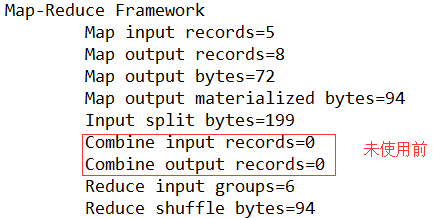
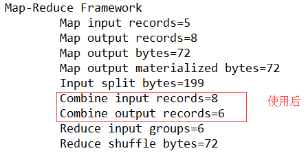
3.4.8 GroupingComparator分组(辅助排序)
对reduce阶段的数据根据某一个或几个字段进行分组。
3.4.9 GroupingComparator分组案例实操
1)需求
有如下订单数据
|
订单id |
商品id |
成交金额 |
|
0000001 |
Pdt_01 |
222.8 |
|
0000001 |
Pdt_06 |
25.8 |
|
0000002 |
Pdt_03 |
522.8 |
|
0000002 |
Pdt_04 |
122.4 |
|
0000002 |
Pdt_05 |
722.4 |
|
0000003 |
Pdt_01 |
222.8 |
|
0000003 |
Pdt_02 |
33.8 |
现在需要求出每一个订单中最贵的商品。
2)输入数据
输出数据预期:
3)分析
(1)利用“订单id和成交金额”作为key,可以将map阶段读取到的所有订单数据按照id分区,按照金额排序,发送到reduce。
(2)在reduce端利用groupingcomparator将订单id相同的kv聚合成组,然后取第一个即是最大值。

4)代码实现
(1)定义订单信息OrderBean
|
package com.atguigu.mapreduce.order; import java.io.DataInput; import java.io.DataOutput; import java.io.IOException; import org.apache.hadoop.io.WritableComparable;
public class OrderBean implements WritableComparable<OrderBean> {
private int order_id; // 订单id号 private double price; // 价格
public OrderBean() { super(); }
public OrderBean(int order_id, double price) { super(); this.order_id = order_id; this.price = price; }
@Override public void write(DataOutput out) throws IOException { out.writeInt(order_id); out.writeDouble(price); }
@Override public void readFields(DataInput in) throws IOException { order_id = in.readInt(); price = in.readDouble(); }
@Override public String toString() { return order_id + "\t" + price; }
public int getOrder_id() { return order_id; }
public void setOrder_id(int order_id) { this.order_id = order_id; }
public double getPrice() { return price; }
public void setPrice(double price) { this.price = price; }
// 二次排序 @Override public int compareTo(OrderBean o) {
int result;
if (order_id > o.getOrder_id()) { result = 1; } else if (order_id < o.getOrder_id()) { result = -1; } else { // 价格倒序排序 result = price > o.getPrice() ? -1 : 1; }
return result; } } |
(2)编写OrderSortMapper
|
package com.atguigu.mapreduce.order; import java.io.IOException; import org.apache.hadoop.io.LongWritable; import org.apache.hadoop.io.NullWritable; import org.apache.hadoop.io.Text; import org.apache.hadoop.mapreduce.Mapper;
public class OrderMapper extends Mapper<LongWritable, Text, OrderBean, NullWritable> { OrderBean k = new OrderBean(); @Override protected void map(LongWritable key, Text value, Context context) throws IOException, InterruptedException { // 1 获取一行 String line = value.toString(); // 2 截取 String[] fields = line.split("\t"); // 3 封装对象 k.setOrder_id(Integer.parseInt(fields[0])); k.setPrice(Double.parseDouble(fields[2])); // 4 写出 context.write(k, NullWritable.get()); } } |
(3)编写OrderSortPartitioner
|
package com.atguigu.mapreduce.order; import org.apache.hadoop.io.NullWritable; import org.apache.hadoop.mapreduce.Partitioner;
public class OrderPartitioner extends Partitioner<OrderBean, NullWritable> {
@Override public int getPartition(OrderBean key, NullWritable value, int numReduceTasks) { return (key.getOrder_id() & Integer.MAX_VALUE) % numReduceTasks; } } |
(4)编写OrderSortGroupingComparator
|
package com.atguigu.mapreduce.order; import org.apache.hadoop.io.WritableComparable; import org.apache.hadoop.io.WritableComparator;
public class OrderGroupingComparator extends WritableComparator {
protected OrderGroupingComparator() { super(OrderBean.class, true); }
@SuppressWarnings("rawtypes") @Override public int compare(WritableComparable a, WritableComparable b) {
OrderBean aBean = (OrderBean) a; OrderBean bBean = (OrderBean) b;
int result; if (aBean.getOrder_id() > bBean.getOrder_id()) { result = 1; } else if (aBean.getOrder_id() < bBean.getOrder_id()) { result = -1; } else { result = 0; }
return result; } } |
(5)编写OrderSortReducer
|
package com.atguigu.mapreduce.order; import java.io.IOException; import org.apache.hadoop.io.NullWritable; import org.apache.hadoop.mapreduce.Reducer;
public class OrderReducer extends Reducer<OrderBean, NullWritable, OrderBean, NullWritable> {
@Override protected void reduce(OrderBean key, Iterable<NullWritable> values, Context context) throws IOException, InterruptedException { context.write(key, NullWritable.get()); } } |
(6)编写OrderSortDriver
|
package com.atguigu.mapreduce.order; import java.io.IOException; import org.apache.hadoop.conf.Configuration; import org.apache.hadoop.fs.Path; import org.apache.hadoop.io.NullWritable; import org.apache.hadoop.mapreduce.Job; import org.apache.hadoop.mapreduce.lib.input.FileInputFormat; import org.apache.hadoop.mapreduce.lib.output.FileOutputFormat;
public class OrderDriver {
public static void main(String[] args) throws Exception, IOException {
// 1 获取配置信息 Configuration conf = new Configuration(); Job job = Job.getInstance(conf);
// 2 设置jar包加载路径 job.setJarByClass(OrderDriver.class);
// 3 加载map/reduce类 job.setMapperClass(OrderMapper.class); job.setReducerClass(OrderReducer.class);
// 4 设置map输出数据key和value类型 job.setMapOutputKeyClass(OrderBean.class); job.setMapOutputValueClass(NullWritable.class);
// 5 设置最终输出数据的key和value类型 job.setOutputKeyClass(OrderBean.class); job.setOutputValueClass(NullWritable.class);
// 6 设置输入数据和输出数据路径 FileInputFormat.setInputPaths(job, new Path(args[0])); FileOutputFormat.setOutputPath(job, new Path(args[1]));
// 10 设置reduce端的分组 job.setGroupingComparatorClass(OrderGroupingComparator.class);
// 7 设置分区 job.setPartitionerClass(OrderPartitioner.class);
// 8 设置reduce个数 job.setNumReduceTasks(3);
// 9 提交 boolean result = job.waitForCompletion(true); System.exit(result ? 0 : 1); } } |
3.5 ReduceTask工作机制
1)设置ReduceTask并行度(个数)
reducetask的并行度同样影响整个job的执行并发度和执行效率,但与maptask的并发数由切片数决定不同,Reducetask数量的决定是可以直接手动设置:
|
//默认值是1,手动设置为4 job.setNumReduceTasks(4); |
2)注意
(1)reducetask=0 ,表示没有reduce阶段,输出文件个数和map个数一致。
(2)reducetask默认值就是1,所以输出文件个数为一个。
(3)如果数据分布不均匀,就有可能在reduce阶段产生数据倾斜
(4)reducetask数量并不是任意设置,还要考虑业务逻辑需求,有些情况下,需要计算全局汇总结果,就只能有1个reducetask。
(5)具体多少个reducetask,需要根据集群性能而定。
(6)如果分区数不是1,但是reducetask为1,是否执行分区过程。答案是:不执行分区过程。因为在maptask的源码中,执行分区的前提是先判断reduceNum个数是否大于1。不大于1肯定不执行。
3)实验:测试reducetask多少合适。
(1)实验环境:1个master节点,16个slave节点:CPU:8GHZ,内存: 2G
(2)实验结论:
表1 改变reduce task (数据量为1GB)
|
Map task =16 |
||||||||||
|
Reduce task |
1 |
5 |
10 |
15 |
16 |
20 |
25 |
30 |
45 |
60 |
|
总时间 |
892 |
146 |
110 |
92 |
88 |
100 |
128 |
101 |
145 |
104 |
4)ReduceTask工作机制
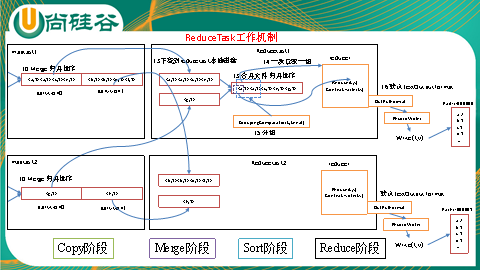
(1)Copy阶段:ReduceTask从各个MapTask上远程拷贝一片数据,并针对某一片数据,如果其大小超过一定阈值,则写到磁盘上,否则直接放到内存中。
(2)Merge阶段:在远程拷贝数据的同时,ReduceTask启动了两个后台线程对内存和磁盘上的文件进行合并,以防止内存使用过多或磁盘上文件过多。
(3)Sort阶段:按照MapReduce语义,用户编写reduce()函数输入数据是按key进行聚集的一组数据。为了将key相同的数据聚在一起,Hadoop采用了基于排序的策略。由于各个MapTask已经实现对自己的处理结果进行了局部排序,因此,ReduceTask只需对所有数据进行一次归并排序即可。
(4)Reduce阶段:reduce()函数将计算结果写到HDFS上。
3.6 OutputFormat数据输出
3.6.1 OutputFormat接口实现类
OutputFormat是MapReduce输出的基类,所有实现MapReduce输出都实现了 OutputFormat接口。下面我们介绍几种常见的OutputFormat实现类。
1)文本输出TextOutputFormat
默认的输出格式是TextOutputFormat,它把每条记录写为文本行。它的键和值可以是任意类型,因为TextOutputFormat调用toString()方法把它们转换为字符串。
2)SequenceFileOutputFormat
SequenceFileOutputFormat将它的输出写为一个顺序文件。如果输出需要作为后续 MapReduce任务的输入,这便是一种好的输出格式,因为它的格式紧凑,很容易被压缩。
3)自定义OutputFormat
根据用户需求,自定义实现输出。
3.6.2 自定义OutputFormat
为了实现控制最终文件的输出路径,可以自定义OutputFormat。
要在一个mapreduce程序中根据数据的不同输出两类结果到不同目录,这类灵活的输出需求可以通过自定义outputformat来实现。
1)自定义OutputFormat步骤
(1)自定义一个类继承FileOutputFormat。
(2)改写recordwriter,具体改写输出数据的方法write()。
3.6.3 自定义OutputFormat案例实操
1)需求
过滤输入的log日志中是否包含atguigu
(1)包含atguigu的网站输出到e:/atguigu.log
(2)不包含atguigu的网站输出到e:/other.log
2)输入数据
输出预期:
https://share.weiyun.com/5NKNZrr
https://share.weiyun.com/53u8ajf
3)具体程序:
(1)自定义一个outputformat
|
package com.atguigu.mapreduce.outputformat; import java.io.IOException; import org.apache.hadoop.io.NullWritable; import org.apache.hadoop.io.Text; import org.apache.hadoop.mapreduce.RecordWriter; import org.apache.hadoop.mapreduce.TaskAttemptContext; import org.apache.hadoop.mapreduce.lib.output.FileOutputFormat;
public class FilterOutputFormat extends FileOutputFormat<Text, NullWritable>{
@Override public RecordWriter<Text, NullWritable> getRecordWriter(TaskAttemptContext job) throws IOException, InterruptedException {
// 创建一个RecordWriter return new FilterRecordWriter(job); } } |
(2)具体的写数据RecordWriter
|
package com.atguigu.mapreduce.outputformat; import java.io.IOException; import org.apache.hadoop.fs.FSDataOutputStream; import org.apache.hadoop.fs.FileSystem; import org.apache.hadoop.fs.Path; import org.apache.hadoop.io.NullWritable; import org.apache.hadoop.io.Text; import org.apache.hadoop.mapreduce.RecordWriter; import org.apache.hadoop.mapreduce.TaskAttemptContext;
public class FilterRecordWriter extends RecordWriter<Text, NullWritable> { FSDataOutputStream atguiguOut = null; FSDataOutputStream otherOut = null;
public FilterRecordWriter(TaskAttemptContext job) { // 1 获取文件系统 FileSystem fs;
try { fs = FileSystem.get(job.getConfiguration());
// 2 创建输出文件路径 Path atguiguPath = new Path("e:/atguigu.log"); Path otherPath = new Path("e:/other.log");
// 3 创建输出流 atguiguOut = fs.create(atguiguPath); otherOut = fs.create(otherPath); } catch (IOException e) { e.printStackTrace(); } }
@Override public void write(Text key, NullWritable value) throws IOException, InterruptedException {
// 判断是否包含“atguigu”输出到不同文件 if (key.toString().contains("atguigu")) { atguiguOut.write(key.toString().getBytes()); } else { otherOut.write(key.toString().getBytes()); } }
@Override public void close(TaskAttemptContext context) throws IOException, InterruptedException { // 关闭资源 if (atguiguOut != null) { atguiguOut.close(); } if (otherOut != null) { otherOut.close(); } } } |
(3)编写FilterMapper
|
package com.atguigu.mapreduce.outputformat; import java.io.IOException; import org.apache.hadoop.io.LongWritable; import org.apache.hadoop.io.NullWritable; import org.apache.hadoop.io.Text; import org.apache.hadoop.mapreduce.Mapper;
public class FilterMapper extends Mapper<LongWritable, Text, Text, NullWritable>{ Text k = new Text(); @Override protected void map(LongWritable key, Text value, Context context) throws IOException, InterruptedException { // 1 获取一行 String line = value.toString(); k.set(line); // 3 写出 context.write(k, NullWritable.get()); } } |
(4)编写FilterReducer
|
package com.atguigu.mapreduce.outputformat; import java.io.IOException; import org.apache.hadoop.io.NullWritable; import org.apache.hadoop.io.Text; import org.apache.hadoop.mapreduce.Reducer;
public class FilterReducer extends Reducer<Text, NullWritable, Text, NullWritable> {
@Override protected void reduce(Text key, Iterable<NullWritable> values, Context context) throws IOException, InterruptedException {
String k = key.toString(); k = k + "\r\n";
context.write(new Text(k), NullWritable.get()); } } |
(5)编写FilterDriver
|
package com.atguigu.mapreduce.outputformat; import org.apache.hadoop.conf.Configuration; import org.apache.hadoop.fs.Path; import org.apache.hadoop.io.NullWritable; import org.apache.hadoop.io.Text; import org.apache.hadoop.mapreduce.Job; import org.apache.hadoop.mapreduce.lib.input.FileInputFormat; import org.apache.hadoop.mapreduce.lib.output.FileOutputFormat;
public class FilterDriver { public static void main(String[] args) throws Exception {
args = new String[] { "e:/input/inputoutputformat", "e:/output2" };
Configuration conf = new Configuration();
Job job = Job.getInstance(conf);
job.setJarByClass(FilterDriver.class); job.setMapperClass(FilterMapper.class); job.setReducerClass(FilterReducer.class);
job.setMapOutputKeyClass(Text.class); job.setMapOutputValueClass(NullWritable.class); job.setOutputKeyClass(Text.class); job.setOutputValueClass(NullWritable.class);
// 要将自定义的输出格式组件设置到job中 job.setOutputFormatClass(FilterOutputFormat.class);
FileInputFormat.setInputPaths(job, new Path(args[0]));
// 虽然我们自定义了outputformat,但是因为我们的outputformat继承自fileoutputformat // 而fileoutputformat要输出一个_SUCCESS文件,所以,在这还得指定一个输出目录 FileOutputFormat.setOutputPath(job, new Path(args[1]));
boolean result = job.waitForCompletion(true); System.exit(result ? 0 : 1); } } |
3.7 Join多种应用
3.7.1 Reduce join
1)原理:
Map端的主要工作:为来自不同表(文件)的key/value对打标签以区别不同来源的记录。然后用连接字段作为key,其余部分和新加的标志作为value,最后进行输出。
Reduce端的主要工作:在reduce端以连接字段作为key的分组已经完成,我们只需要在每一个分组当中将那些来源于不同文件的记录(在map阶段已经打标志)分开,最后进行合并就ok了。
2)该方法的缺点
这种方式的缺点很明显就是会造成map和reduce端也就是shuffle阶段出现大量的数据传输,效率很低。
3.7.2 Reduce join案例实操
1)需求:
订单数据表t_order:
|
id |
pid |
amount |
|
1001 |
01 |
1 |
|
1002 |
02 |
2 |
|
1003 |
03 |
3 |
商品信息表t_product
|
pid |
pname |
|
01 |
小米 |
|
02 |
华为 |
|
03 |
格力 |
将商品信息表中数据根据商品pid合并到订单数据表中。
最终数据形式:
|
id |
pname |
amount |
|
1001 |
小米 |
1 |
|
1004 |
小米 |
4 |
|
1002 |
华为 |
2 |
|
1005 |
华为 |
5 |
|
1003 |
格力 |
3 |
|
1006 |
格力 |
6 |
通过将关联条件作为map输出的key,将两表满足join条件的数据并携带数据所来源的文件信息,发往同一个reduce task,在reduce中进行数据的串联。
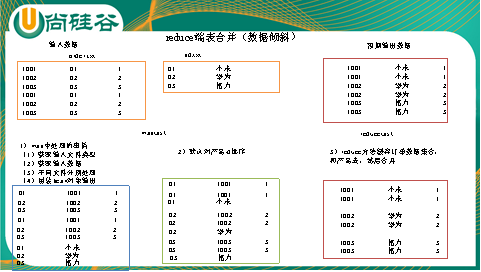
1)创建商品和订合并后的bean类
|
package com.atguigu.mapreduce.table; import java.io.DataInput; import java.io.DataOutput; import java.io.IOException; import org.apache.hadoop.io.Writable;
public class TableBean implements Writable { private String order_id; // 订单id private String p_id; // 产品id private int amount; // 产品数量 private String pname; // 产品名称 private String flag;// 表的标记
public TableBean() { super(); }
public TableBean(String order_id, String p_id, int amount, String pname, String flag) { super(); this.order_id = order_id; this.p_id = p_id; this.amount = amount; this.pname = pname; this.flag = flag; }
public String getFlag() { return flag; }
public void setFlag(String flag) { this.flag = flag; }
public String getOrder_id() { return order_id; }
public void setOrder_id(String order_id) { this.order_id = order_id; }
public String getP_id() { return p_id; }
public void setP_id(String p_id) { this.p_id = p_id; }
public int getAmount() { return amount; }
public void setAmount(int amount) { this.amount = amount; }
public String getPname() { return pname; }
public void setPname(String pname) { this.pname = pname; }
@Override public void write(DataOutput out) throws IOException { out.writeUTF(order_id); out.writeUTF(p_id); out.writeInt(amount); out.writeUTF(pname); out.writeUTF(flag); }
@Override public void readFields(DataInput in) throws IOException { this.order_id = in.readUTF(); this.p_id = in.readUTF(); this.amount = in.readInt(); this.pname = in.readUTF(); this.flag = in.readUTF(); }
@Override public String toString() { return order_id + "\t" + pname + "\t" + amount + "\t" ; } } |
2)编写TableMapper程序
|
package com.atguigu.mapreduce.table; import java.io.IOException; import org.apache.hadoop.io.LongWritable; import org.apache.hadoop.io.Text; import org.apache.hadoop.mapreduce.Mapper; import org.apache.hadoop.mapreduce.lib.input.FileSplit;
public class TableMapper extends Mapper<LongWritable, Text, Text, TableBean>{ TableBean bean = new TableBean(); Text k = new Text(); @Override protected void map(LongWritable key, Text value, Context context) throws IOException, InterruptedException { // 1 获取输入文件类型 FileSplit split = (FileSplit) context.getInputSplit(); String name = split.getPath().getName(); // 2 获取输入数据 String line = value.toString(); // 3 不同文件分别处理 if (name.startsWith("order")) {// 订单表处理 // 3.1 切割 String[] fields = line.split("\t"); // 3.2 封装bean对象 bean.setOrder_id(fields[0]); bean.setP_id(fields[1]); bean.setAmount(Integer.parseInt(fields[2])); bean.setPname(""); bean.setFlag("0"); k.set(fields[1]); }else {// 产品表处理 // 3.3 切割 String[] fields = line.split("\t"); // 3.4 封装bean对象 bean.setP_id(fields[0]); bean.setPname(fields[1]); bean.setFlag("1"); bean.setAmount(0); bean.setOrder_id(""); k.set(fields[0]); } // 4 写出 context.write(k, bean); } } |
3)编写TableReducer程序
|
package com.atguigu.mapreduce.table; import java.io.IOException; import java.util.ArrayList; import org.apache.commons.beanutils.BeanUtils; import org.apache.hadoop.io.NullWritable; import org.apache.hadoop.io.Text; import org.apache.hadoop.mapreduce.Reducer;
public class TableReducer extends Reducer<Text, TableBean, TableBean, NullWritable> {
@Override protected void reduce(Text key, Iterable<TableBean> values, Context context) throws IOException, InterruptedException {
// 1准备存储订单的集合 ArrayList<TableBean> orderBeans = new ArrayList<>(); // 2 准备bean对象 TableBean pdBean = new TableBean();
for (TableBean bean : values) {
if ("0".equals(bean.getFlag())) {// 订单表 // 拷贝传递过来的每条订单数据到集合中 TableBean orderBean = new TableBean(); try { BeanUtils.copyProperties(orderBean, bean); } catch (Exception e) { e.printStackTrace(); }
orderBeans.add(orderBean); } else {// 产品表 try { // 拷贝传递过来的产品表到内存中 BeanUtils.copyProperties(pdBean, bean); } catch (Exception e) { e.printStackTrace(); } } }
// 3 表的拼接 for(TableBean bean:orderBeans){ bean.setPname (pdBean.getPname()); // 4 数据写出去 context.write(bean, NullWritable.get()); } } } |
4)编写TableDriver程序
|
package com.atguigu.mapreduce.table; import org.apache.hadoop.conf.Configuration; import org.apache.hadoop.fs.Path; import org.apache.hadoop.io.NullWritable; import org.apache.hadoop.io.Text; import org.apache.hadoop.mapreduce.Job; import org.apache.hadoop.mapreduce.lib.input.FileInputFormat; import org.apache.hadoop.mapreduce.lib.output.FileOutputFormat;
public class TableDriver {
public static void main(String[] args) throws Exception { // 1 获取配置信息,或者job对象实例 Configuration configuration = new Configuration(); Job job = Job.getInstance(configuration);
// 2 指定本程序的jar包所在的本地路径 job.setJarByClass(TableDriver.class);
// 3 指定本业务job要使用的mapper/Reducer业务类 job.setMapperClass(TableMapper.class); job.setReducerClass(TableReducer.class);
// 4 指定mapper输出数据的kv类型 job.setMapOutputKeyClass(Text.class); job.setMapOutputValueClass(TableBean.class);
// 5 指定最终输出的数据的kv类型 job.setOutputKeyClass(TableBean.class); job.setOutputValueClass(NullWritable.class);
// 6 指定job的输入原始文件所在目录 FileInputFormat.setInputPaths(job, new Path(args[0])); FileOutputFormat.setOutputPath(job, new Path(args[1]));
// 7 将job中配置的相关参数,以及job所用的java类所在的jar包, 提交给yarn去运行 boolean result = job.waitForCompletion(true); System.exit(result ? 0 : 1); } } |
3)运行程序查看结果
|
1001 小米 1 1001 小米 1 1002 华为 2 1002 华为 2 1003 格力 3 1003 格力 3 |
缺点:这种方式中,合并的操作是在reduce阶段完成,reduce端的处理压力太大,map节点的运算负载则很低,资源利用率不高,且在reduce阶段极易产生数据倾斜
解决方案: map端实现数据合并
3.7.3 Map join
1)使用场景:一张表十分小、一张表很大。
2)解决方案
在map端缓存多张表,提前处理业务逻辑,这样增加map端业务,减少reduce端数据的压力,尽可能的减少数据倾斜。
3)具体办法:采用distributedcache
(1)在mapper的setup阶段,将文件读取到缓存集合中。
(2)在驱动函数中加载缓存。
job.addCacheFile(new URI("file:/e:/mapjoincache/pd.txt"));// 缓存普通文件到task运行节点
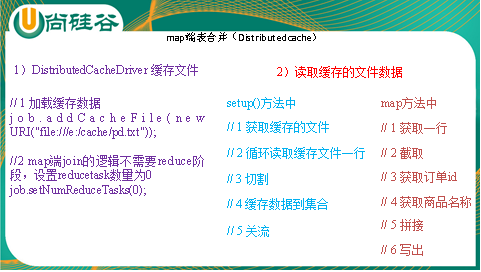
3.7.4 Map join案例实操
1)分析
适用于关联表中有小表的情形;
可以将小表分发到所有的map节点,这样,map节点就可以在本地对自己所读到的大表数据进行合并并输出最终结果,可以大大提高合并操作的并发度,加快处理速度。
2)实现代码:
(1)先在驱动模块中添加缓存文件
|
package test; import java.net.URI; import org.apache.hadoop.conf.Configuration; import org.apache.hadoop.fs.Path; import org.apache.hadoop.io.NullWritable; import org.apache.hadoop.io.Text; import org.apache.hadoop.mapreduce.Job; import org.apache.hadoop.mapreduce.lib.input.FileInputFormat; import org.apache.hadoop.mapreduce.lib.output.FileOutputFormat;
public class DistributedCacheDriver {
public static void main(String[] args) throws Exception { // 1 获取job信息 Configuration configuration = new Configuration(); Job job = Job.getInstance(configuration);
// 2 设置加载jar包路径 job.setJarByClass(DistributedCacheDriver.class);
// 3 关联map job.setMapperClass(DistributedCacheMapper.class); // 4 设置最终输出数据类型 job.setOutputKeyClass(Text.class); job.setOutputValueClass(NullWritable.class);
// 5 设置输入输出路径 FileInputFormat.setInputPaths(job, new Path(args[0])); FileOutputFormat.setOutputPath(job, new Path(args[1]));
// 6 加载缓存数据 job.addCacheFile(new URI("file:///e:/tableinput/pd.txt")); // 7 map端join的逻辑不需要reduce阶段,设置reducetask数量为0 job.setNumReduceTasks(0);
// 8 提交 boolean result = job.waitForCompletion(true); System.exit(result ? 0 : 1); } } |
(2)读取缓存的文件数据
|
package test; import java.io.BufferedReader; import java.io.FileInputStream; import java.io.IOException; import java.io.InputStreamReader; import java.util.HashMap; import java.util.Map; import org.apache.commons.lang.StringUtils; import org.apache.hadoop.io.LongWritable; import org.apache.hadoop.io.NullWritable; import org.apache.hadoop.io.Text; import org.apache.hadoop.mapreduce.Mapper;
public class DistributedCacheMapper extends Mapper<LongWritable, Text, Text, NullWritable>{
Map<String, String> pdMap = new HashMap<>(); @Override protected void setup(Mapper<LongWritable, Text, Text, NullWritable>.Context context) throws IOException, InterruptedException {
// 1获取缓存文件 URI[] cacheFiles = context.getCacheFiles(); FileInputStream fis = new FileInputStream(cacheFiles[0].getPath().toString()); InputStreamReader isr = new InputStreamReader(fis, "UTF-8"); BufferedReader reader = new BufferedReader(isr); String line; while(StringUtils.isNotEmpty(line = reader.readLine())){ // 2 切割 String[] fields = line.split("\t"); // 3 缓存数据到集合 pdMap.put(fields[0], fields[1]); } // 4 关流 reader.close(); } Text k = new Text(); @Override protected void map(LongWritable key, Text value, Context context) throws IOException, InterruptedException { // 1 获取一行 String line = value.toString(); // 2 截取 String[] fields = line.split("\t"); // 3 获取产品id String pId = fields[1]; // 4 获取商品名称 String pdName = pdMap.get(pId); // 5 拼接 k.set(line + "\t"+ pdName); // 6 写出 context.write(k, NullWritable.get()); } } |
3.8 计数器应用
Hadoop为每个作业维护若干内置计数器,以描述多项指标。例如,某些计数器记录已处理的字节数和记录数,使用户可监控已处理的输入数据量和已产生的输出数据量。
1)API
(1)采用枚举的方式统计计数
enum MyCounter{MALFORORMED,NORMAL}
//对枚举定义的自定义计数器加1
context.getCounter(MyCounter.MALFORORMED).increment(1);
(2)采用计数器组、计数器名称的方式统计
context.getCounter("counterGroup", "countera").increment(1);
组名和计数器名称随便起,但最好有意义。
(3)计数结果在程序运行后的控制台上查看。
3.9 数据清洗(ETL)
1)概述
在运行核心业务Mapreduce程序之前,往往要先对数据进行清洗,清理掉不符合用户要求的数据。清理的过程往往只需要运行mapper程序,不需要运行reduce程序。
3.10 数据清洗案例实操
3.10.1 简单解析版
1)需求:
去除日志中字段长度小于等于11的日志。
2)输入数据
https://share.weiyun.com/5Qwyce5
3)实现代码:
(1)编写LogMapper
|
package com.atguigu.mapreduce.weblog; import java.io.IOException; import org.apache.hadoop.io.LongWritable; import org.apache.hadoop.io.NullWritable; import org.apache.hadoop.io.Text; import org.apache.hadoop.mapreduce.Mapper;
public class LogMapper extends Mapper<LongWritable, Text, Text, NullWritable>{ Text k = new Text(); @Override protected void map(LongWritable key, Text value, Context context) throws IOException, InterruptedException { // 1 获取1行数据 String line = value.toString(); // 2 解析日志 boolean result = parseLog(line,context); // 3 日志不合法退出 if (!result) { return; } // 4 设置key k.set(line); // 5 写出数据 context.write(k, NullWritable.get()); }
// 2 解析日志 private boolean parseLog(String line, Context context) { // 1 截取 String[] fields = line.split(" "); // 2 日志长度大于11的为合法 if (fields.length > 11) { // 系统计数器 context.getCounter("map", "true").increment(1); return true; }else { context.getCounter("map", "false").increment(1); return false; } } } |
(2)编写LogDriver
|
package com.atguigu.mapreduce.weblog; import org.apache.hadoop.conf.Configuration; import org.apache.hadoop.fs.Path; import org.apache.hadoop.io.NullWritable; import org.apache.hadoop.io.Text; import org.apache.hadoop.mapreduce.Job; import org.apache.hadoop.mapreduce.lib.input.FileInputFormat; import org.apache.hadoop.mapreduce.lib.output.FileOutputFormat;
public class LogDriver {
public static void main(String[] args) throws Exception {
args = new String[] { "e:/input/inputlog", "e:/output1" };
// 1 获取job信息 Configuration conf = new Configuration(); Job job = Job.getInstance(conf);
// 2 加载jar包 job.setJarByClass(LogDriver.class);
// 3 关联map job.setMapperClass(LogMapper.class);
// 4 设置最终输出类型 job.setOutputKeyClass(Text.class); job.setOutputValueClass(NullWritable.class);
// 设置reducetask个数为0 job.setNumReduceTasks(0);
// 5 设置输入和输出路径 FileInputFormat.setInputPaths(job, new Path(args[0])); FileOutputFormat.setOutputPath(job, new Path(args[1]));
// 6 提交 job.waitForCompletion(true); } } |
3.10.2 复杂解析版
1)需求:
对web访问日志中的各字段识别切分
去除日志中不合法的记录
根据统计需求,生成各类访问请求过滤数据
2)输入数据
https://share.weiyun.com/5Yy3A59
3)实现代码:
(1)定义一个bean,用来记录日志数据中的各数据字段
|
package com.atguigu.mapreduce.log;
public class LogBean { private String remote_addr;// 记录客户端的ip地址 private String remote_user;// 记录客户端用户名称,忽略属性"-" private String time_local;// 记录访问时间与时区 private String request;// 记录请求的url与http协议 private String status;// 记录请求状态;成功是200 private String body_bytes_sent;// 记录发送给客户端文件主体内容大小 private String http_referer;// 用来记录从那个页面链接访问过来的 private String http_user_agent;// 记录客户浏览器的相关信息
private boolean valid = true;// 判断数据是否合法
public String getRemote_addr() { return remote_addr; }
public void setRemote_addr(String remote_addr) { this.remote_addr = remote_addr; }
public String getRemote_user() { return remote_user; }
public void setRemote_user(String remote_user) { this.remote_user = remote_user; }
public String getTime_local() { return time_local; }
public void setTime_local(String time_local) { this.time_local = time_local; }
public String getRequest() { return request; }
public void setRequest(String request) { this.request = request; }
public String getStatus() { return status; }
public void setStatus(String status) { this.status = status; }
public String getBody_bytes_sent() { return body_bytes_sent; }
public void setBody_bytes_sent(String body_bytes_sent) { this.body_bytes_sent = body_bytes_sent; }
public String getHttp_referer() { return http_referer; }
public void setHttp_referer(String http_referer) { this.http_referer = http_referer; }
public String getHttp_user_agent() { return http_user_agent; }
public void setHttp_user_agent(String http_user_agent) { this.http_user_agent = http_user_agent; }
public boolean isValid() { return valid; }
public void setValid(boolean valid) { this.valid = valid; }
@Override public String toString() { StringBuilder sb = new StringBuilder(); sb.append(this.valid); sb.append("\001").append(this.remote_addr); sb.append("\001").append(this.remote_user); sb.append("\001").append(this.time_local); sb.append("\001").append(this.request); sb.append("\001").append(this.status); sb.append("\001").append(this.body_bytes_sent); sb.append("\001").append(this.http_referer); sb.append("\001").append(this.http_user_agent); return sb.toString(); } } |
(2)编写LogMapper程序
|
package com.atguigu.mapreduce.log; import java.io.IOException; import org.apache.hadoop.io.LongWritable; import org.apache.hadoop.io.NullWritable; import org.apache.hadoop.io.Text; import org.apache.hadoop.mapreduce.Mapper;
public class LogMapper extends Mapper<LongWritable, Text, Text, NullWritable>{ Text k = new Text(); @Override protected void map(LongWritable key, Text value, Context context) throws IOException, InterruptedException { // 1 获取1行 String line = value.toString(); // 2 解析日志是否合法 LogBean bean = pressLog(line); if (!bean.isValid()) { return; } k.set(bean.toString()); // 3 输出 context.write(k, NullWritable.get()); }
// 解析日志 private LogBean pressLog(String line) { LogBean logBean = new LogBean(); // 1 截取 String[] fields = line.split(" "); if (fields.length > 11) { // 2封装数据 logBean.setRemote_addr(fields[0]); logBean.setRemote_user(fields[1]); logBean.setTime_local(fields[3].substring(1)); logBean.setRequest(fields[6]); logBean.setStatus(fields[8]); logBean.setBody_bytes_sent(fields[9]); logBean.setHttp_referer(fields[10]); if (fields.length > 12) { logBean.setHttp_user_agent(fields[11] + " "+ fields[12]); }else { logBean.setHttp_user_agent(fields[11]); } // 大于400,HTTP错误 if (Integer.parseInt(logBean.getStatus()) >= 400) { logBean.setValid(false); } }else { logBean.setValid(false); } return logBean; } } |
(3)编写LogDriver程序
|
package com.atguigu.mapreduce.log; import org.apache.hadoop.conf.Configuration; import org.apache.hadoop.fs.Path; import org.apache.hadoop.io.NullWritable; import org.apache.hadoop.io.Text; import org.apache.hadoop.mapreduce.Job; import org.apache.hadoop.mapreduce.lib.input.FileInputFormat; import org.apache.hadoop.mapreduce.lib.output.FileOutputFormat;
public class LogDriver { public static void main(String[] args) throws Exception { // 1 获取job信息 Configuration conf = new Configuration(); Job job = Job.getInstance(conf);
// 2 加载jar包 job.setJarByClass(LogDriver.class);
// 3 关联map job.setMapperClass(LogMapper.class);
// 4 设置最终输出类型 job.setOutputKeyClass(Text.class); job.setOutputValueClass(NullWritable.class);
// 5 设置输入和输出路径 FileInputFormat.setInputPaths(job, new Path(args[0])); FileOutputFormat.setOutputPath(job, new Path(args[1]));
// 6 提交 job.waitForCompletion(true); } } |
3.11 MapReduce开发总结
在编写mapreduce程序时,需要考虑的几个方面:
1)输入数据接口:InputFormat
默认使用的实现类是:TextInputFormat
TextInputFormat的功能逻辑是:一次读一行文本,然后将该行的起始偏移量作为key,行内容作为value返回。
KeyValueTextInputFormat每一行均为一条记录,被分隔符分割为key,value。默认分隔符是tab(\t)。
NlineInputFormat按照指定的行数N来划分切片。
CombineTextInputFormat可以把多个小文件合并成一个切片处理,提高处理效率。
用户还可以自定义InputFormat。
2)逻辑处理接口:Mapper
用户根据业务需求实现其中三个方法:map() setup() cleanup ()
3)Partitioner分区
有默认实现 HashPartitioner,逻辑是根据key的哈希值和numReduces来返回一个分区号;key.hashCode()&Integer.MAXVALUE % numReduces
如果业务上有特别的需求,可以自定义分区。
4)Comparable排序
当我们用自定义的对象作为key来输出时,就必须要实现WritableComparable接口,重写其中的compareTo()方法。
部分排序:对最终输出的每一个文件进行内部排序。
全排序:对所有数据进行排序,通常只有一个Reduce。
二次排序:排序的条件有两个。
5)Combiner合并
Combiner合并可以提高程序执行效率,减少io传输。但是使用时必须不能影响原有的业务处理结果。
6)reduce端分组:Groupingcomparator
reduceTask拿到输入数据(一个partition的所有数据)后,首先需要对数据进行分组,其分组的默认原则是key相同,然后对每一组kv数据调用一次reduce()方法,并且将这一组kv中的第一个kv的key作为参数传给reduce的key,将这一组数据的value的迭代器传给reduce()的values参数。
利用上述这个机制,我们可以实现一个高效的分组取最大值的逻辑。
自定义一个bean对象用来封装我们的数据,然后改写其compareTo方法产生倒序排序的效果。然后自定义一个Groupingcomparator,将bean对象的分组逻辑改成按照我们的业务分组id来分组(比如订单号)。这样,我们要取的最大值就是reduce()方法中传进来key。
7)逻辑处理接口:Reducer
用户根据业务需求实现其中三个方法:reduce() setup() cleanup ()
8)输出数据接口:OutputFormat
默认实现类是TextOutputFormat,功能逻辑是:将每一个KV对向目标文本文件中输出为一行。
SequenceFileOutputFormat将它的输出写为一个顺序文件。如果输出需要作为后续 MapReduce任务的输入,这便是一种好的输出格式,因为它的格式紧凑,很容易被压缩。
用户还可以自定义OutputFormat。
本教程由尚硅谷教育大数据研究院出品,如需转载请注明来源,欢迎大家关注尚硅谷公众号(atguigu)了解更多。


